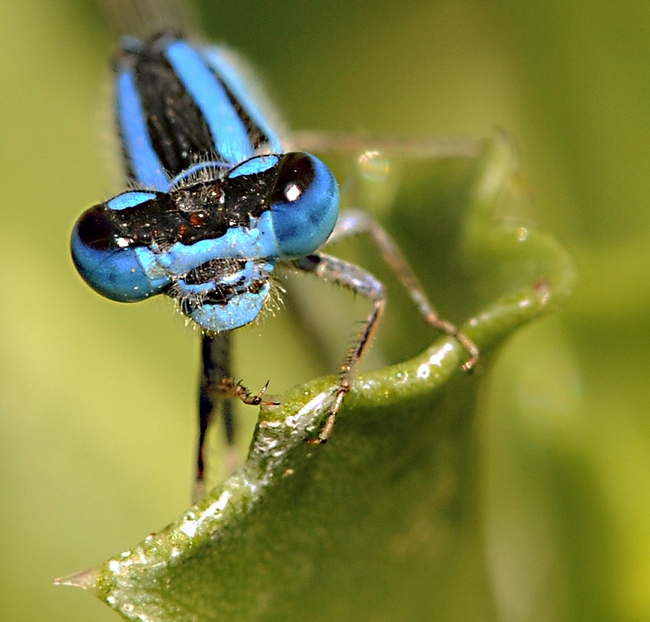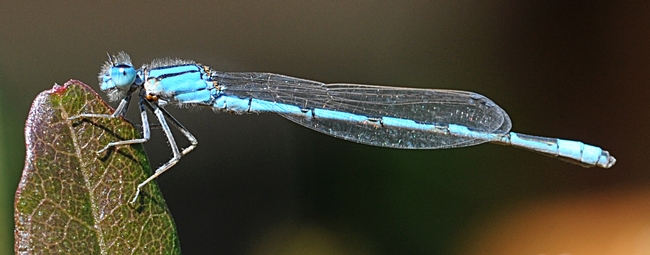- Author: Kathy Keatley Garvey
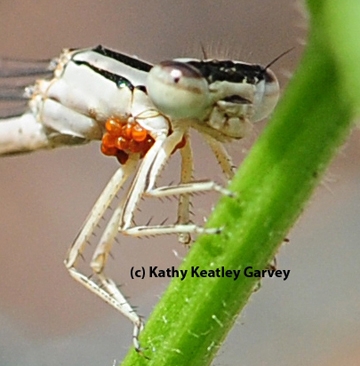
The result was a good one: more damselflies.
Damselflies lay their eggs in water, whether it be a pond, underwater vegetation, or in water-filled cavities in trees. If they lay their eggs in a fish pond, fish feast on the eggs and larvae.
But not this year, not in our pond. One egret. No fish. And now damselflies are no longer in distress.
On any given day, 20 to 25 damselflies flit around our bee garden, searching for food as they land on the stems of the Mexican sunflower (Tithonia), catmint (Nepata), and oregano (Origanum).
They also search for mates and occasionally collide with a bee or butterfly.
Most of the damselflies we see carry the parasitic water mites (Hydracarina), which look like red caviar.

Damselfles and dragonflies belong to the same order, Odonata. Damselflies, however, are typically much smaller than their dragonfly cousins. Wikipedia tells us that damselflies, suborder Zygoptera, can be distinguished from dragonflies "by the fact that the wings of most damselflies are held along, and parallel to, the body when at rest. Furthermore, the hindwing of the damselfly is essentially similar to the forewing, while the hindwing of the dragonfly broadens near the base.
We've never seen a damselfly eat anything or anything eat the damselfly, although our resident praying mantis seemed quite interested--or perturbed--when a damselfly bumped into him.
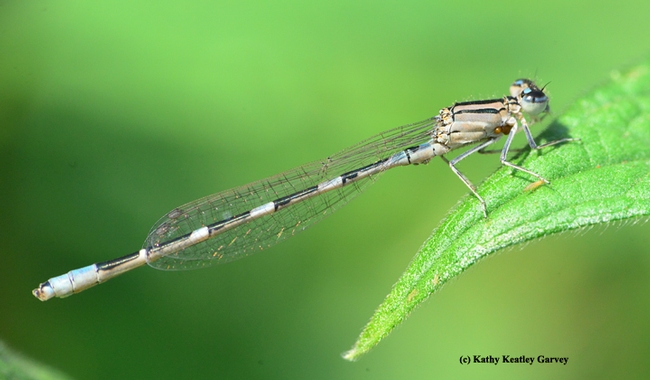
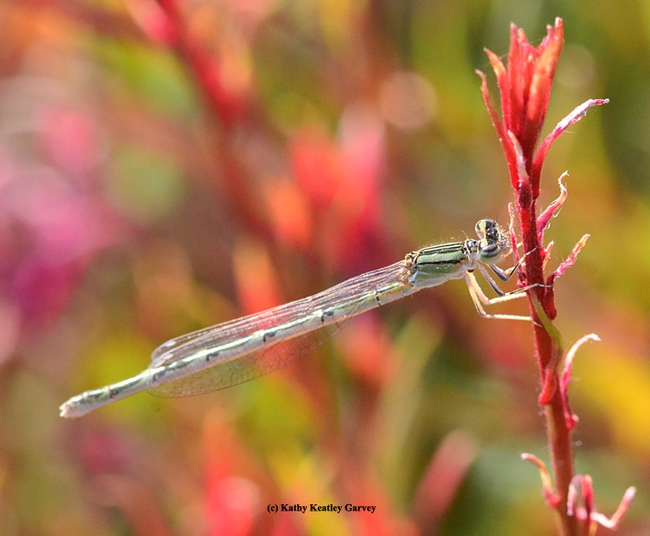
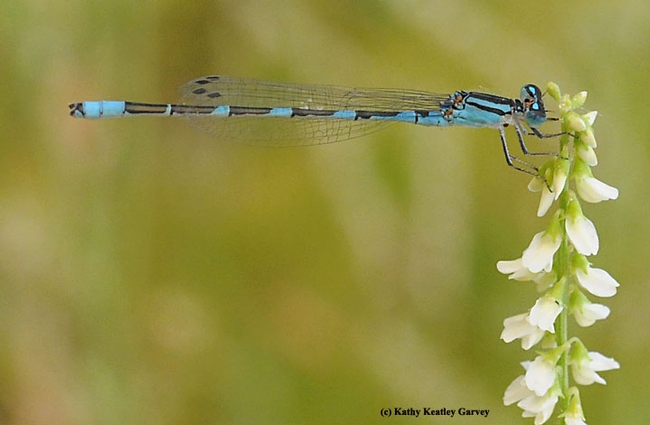
- Author: Kathy Keatley Garvey
I usually can't get within 25 yards of a dragonfly.
Not so in our back yard.
A flame skimmer or firecracker skimmer (Libellula saturata) has apparently decided that this is where he wants to be.
Last Saturday, for nine hours, he perched on a six-foot-high bamboo stake, leaving only for a few seconds at a time to snag a flying insect before returning to eat his prey.
The flame skimmer, about a 2.5-inch Odonata, looks prehistoric. In fact, according to a UC Berkeley website, "The oldest recognizable fossils of the group (Odonata) belong to the Protodonata, an ancestral group that is now extinct. The earliest fossils so far discovered come from Upper Carboniferous (Pennsylvanian) sediments in Europe formed about 325 million years ago. Like modern-day dragonflies, the Protodonata were fast-flying with spiny legs that may have assisted in capturing prey; their wingspan was up to 75 centimeters (30 inches). The group went extinct in the Triassic, about the time that dinosaurs began to appear."
Meanwhile, back in our yard (325 million years into the future), Big Red kept snagging insects and flying back to his six-foot-high perch to eat them. Then occasionally he'd claim a five-foot-high bamboo stake. Too much high rise? A little acrophobia?
At first I kept my distance, hoping I wouldn't frighten him. However, he just looked at me as if I were part of the permanent landscape. Camera movement didn't faze him. After capturing multiple images from every angle possible, I thrust the macro lens about an inch away from his head. He did not move.
Am I a dragonfly whisperer or just lucky?
The flame skimmer prefers a habitat of warm water ponds, slow streams or hot springs. We have a fish pond, a pool and a birdbath in our yard, so I guess that's why he hangs out here.
And we have the perfect perches--bamboo stakes. They're meant to stake our tomato plants but now they're "dragonfly sticks."
We suspect Big Red won't last long. A Mama scrub jay is nesting in our shrubbery and when her babies chirp for food, off she flies in search of a tasty morsel. Mama Bird chased a bright orange gulf fritillary butterfly (missed!) and now, I expect, she'll go after Big Red.
It's a bug-eat-bug world out there, and sometimes it's a bird-eat-bug world when you don't want it to be.





- Author: Kathy Keatley Garvey
If you're around creeks, ponds and irrigation ditches, watch for the dragonflies.
We spotted scores of variegated meadowhawks (Sympetrum corruptum) last Sunday along an irrigation ditch bordering a sunflower field in Winters, Calif.
Like helicopters, they hovered, soared, dropped, sped up and slowed down. Dragonflies can reach speeds up to 30 miles per hour, according to an article, "Chasing Dragons," in the current edition of Audubon.
Written by Jill U. Adams, the article details the art of watching dragonflies, and how this is becoming a passion like birdwatching.
Entomologists call dragonflies "odes," after their order, Odonata. They're also called "dragons."
"Dating back more than 250 million years, odes were around long before the dinosaurs appeared," Adams wrote.
"Odes are easy enough to find at a pond or stream around mid-morning, after the sun has warmed the air. They fly and perch, hunt and mate, from spring until fall."
She quotes dragonfly expert Larry Federman, education coordinator for the three Audubon New York sanctuaries, as saying: "Once you start watching dragonflies, you can't help but notice how amazing they are. They fly at speeds of up to 30 miles per hour, zip forward and backward, pivot in a flash and hover with ease. They prey on live insects in midair, snapping up small bugs with their mouths or grabbing larger ones with their legs, then perching to devour them."
In Winters, we watched their mating rituals. Their bodies hooked together, their double set of wings glittering like precious jewels, they dazzled us with their maneuvers, speed and beauty. So fast, so very fast. (But things are not what they seem; be sure to read National Geographic's piece on the dragonfly mating game.)
What's spectacular about the Audubon feature is a row of 16 dragonfly abdomens lined up like arrowheads or surfboards.
And yes, among the 16 abdomens: the variegated meadowhawk.
It's not as striking as the flame skimmer (that one is firecracker red!), but its coloration is sure to please.

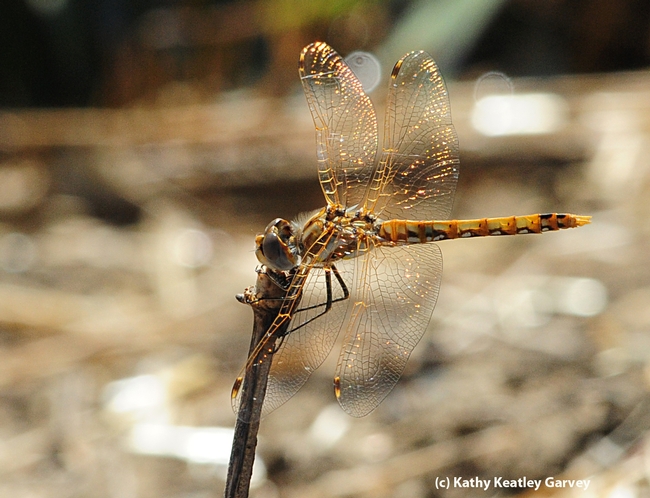
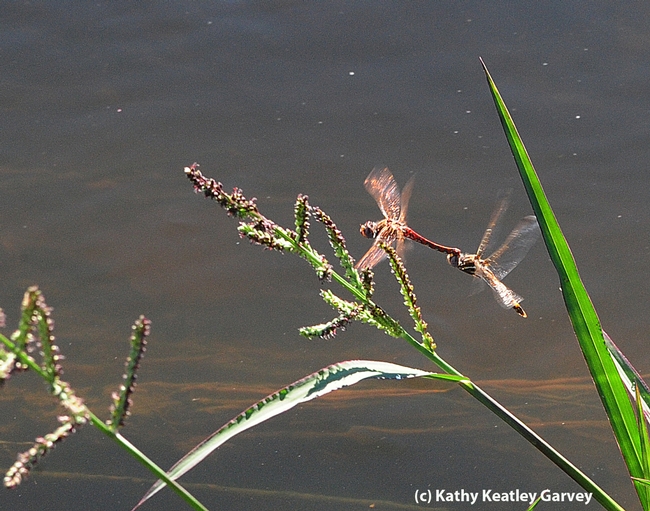
- Author: Kathy Keatley Garvey
Up close and personal, those blue damselflies (suborder Zygoptera, order Odonata) look prehistoric.
Fact is, they were here before the dinosaurs.
These needlelike insects add an iridescent presence as they fly awkwardy over our fish pond, catching prey. In the early morning, they land in our nectarine tree. They're not there to pick nectarines. They're warming their flight muscles.
Their brilliant colors draw us to them. But their huge compound eyes quickly notice us and off they go.
Awkwardly.
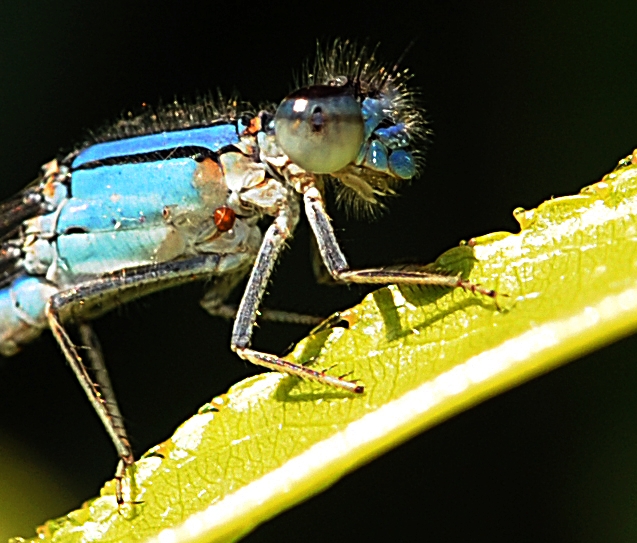
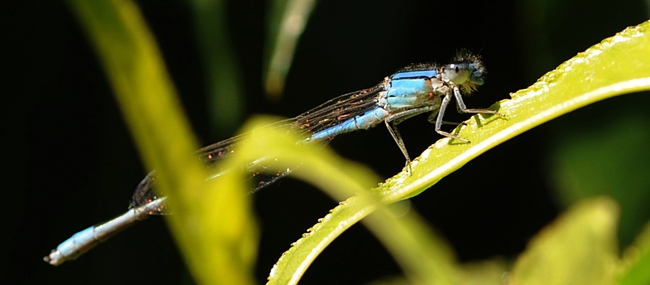
- Author: Kathy Keatley Garvey
Blue damselflies should be on "Dancing with Stars."
Because, in many respects, they ARE the stars--the stars of the insect world.
They're slender, delicate and beautiful dancers that look like blue-stick diamonds.
Damselflies are often confused with dragonflies, which are in the same order, Odonata, but in a different suborder. Both are predators. Damselflies, however, hold their wings parallel to the body. They're usually smaller than dragonflies and don't move as fast.
But if you stalk them, they're leery. If you shadow them, these needlelike insects vanish in a flash of blue.
Fossil records show that dragonflies and damselflies lived on earth 300 million years ago. Ancient insects, indeed.
The best time to photograph damselflies is in the early morning when they're warming their flight muscles. Sometimes they'll perch motionless on a plant as if they're posing.
Poet-playwright William Butler Yeats (1865-1939) asked "How can we know the dancer from the dance?"
We can't.
